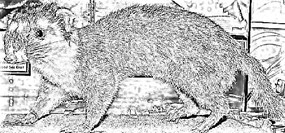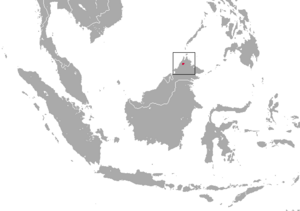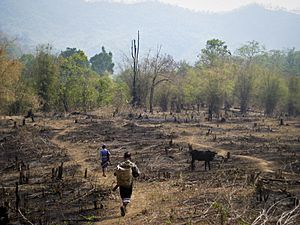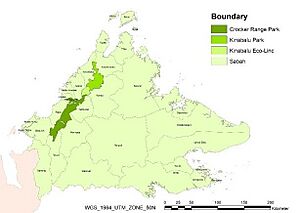Bornean ferret badger facts for kids
Quick facts for kids Bornean ferret badger |
|
|---|---|
 |
|
| Conservation status | |
| Scientific classification | |
| Genus: |
Melogale
|
| Species: |
everetti
|
 |
|
| Bornean ferret badger range | |
The Bornean ferret badger (Melogale everetti) is a small mammal found only on the island of Borneo. It is also called Everett's ferret badger or the Kinabalu ferret badger. This animal is mostly active at night (which means it's nocturnal). It eats both plants and animals (which means it's an omnivore).
The Bornean ferret badger is part of the weasel family, called Mustelidae. It is one of six different types of ferret badgers in the Melogale group. Sadly, it is listed as endangered. This is because it lives in a very small area, mainly in Kinabalu National Park and Crocker Range National Park.
These badgers can weigh up to 3 kilograms (about 6.6 pounds). Their bodies can be up to 44 centimeters (about 17 inches) long. They look for food on the ground, eating small creatures without backbones (like worms), frogs, insects, fruit, and dead animals.
Experts believe the number of Bornean ferret badgers is slowly going down. This is due to problems like climate change and their homes being destroyed by humans. They also face natural dangers like natural disasters and diseases.
Contents
About the Bornean Ferret Badger
What's in a Name?
The scientific name for this animal is Melogale everetti. A British zoologist named Oldfield Thomas first used this name in 1895. The name everetti honors Alfred Hart Everett, a British collector of animals.
In the Malay language, this animal is called Biul Slentek.
For a long time, some people thought the Bornean ferret badger was a type of Javan ferret-badger or Burmese ferret-badger. But now, scientists agree it is its own unique species.
What Does It Look Like?
The Bornean ferret badger has fur that can be grey-brown or dark black. Its belly fur is usually lighter. The easiest way to spot this badger is its "ferret-like mask" on its face. This mask is either white or yellow.
Another special mark is a stripe on its back. This stripe runs from its head down to its shoulders and can be white or red.
Like other ferret badgers, it has short legs and wide feet. Its feet have strong claws for digging. It also has special ridges on its foot pads and some webbing between its toes. These features might help it climb trees.
How Big Are They?
The Bornean ferret badger is small and long compared to other ferret badgers. It usually weighs between 1 and 3 kilograms (2.2 to 6.6 pounds). Its body is about 33 to 44 centimeters (13 to 17 inches) long. It also has a long, bushy tail that can be 15.2 to 23 centimeters (6 to 9 inches) long.
Where Do They Live?
The Bornean ferret badger lives only on the island of Borneo. It has a very small home range, mostly in the northern part of the island. You can find them in Kinabalu National Park, Crocker Range National Park, and nearby areas in Sabah.
The IUCN Red List of Threatened Species says this badger is endangered. This is because its living area is quite small, about 4,200 square kilometers (1,620 square miles). Roads, like the main Sabah highway, cut through its habitat. This makes its actual living space even smaller, only about 1,100 square kilometers (425 square miles).
These badgers mostly live in evergreen and mountain forests. But they have also been seen in nearby bushy areas and old farm fields. They prefer higher places, usually between 500 and 3000 meters (1,640 and 9,840 feet) above sea level.
How Many Are There?
We don't know much about how many Bornean ferret badgers there are. In the late 1960s and early 1970s, 57 badgers were collected and are now in the Sabah Museum. Most sightings have been of single badgers, making it hard to count them.
Scientists have used camera-traps to study them. One study found fewer Bornean ferret badgers than other similar-sized animals. This suggested they might be rare. However, another study in 2016 said the opposite, suggesting they might be one of the most common small meat-eating animals in the area. But camera traps don't give exact numbers of how many animals are truly there.
Experts believe the number of Bornean ferret badgers is likely going down. This is because their homes are being changed or destroyed. They might not be able to live well in small farm fields that are not surrounded by old forests.
What Do They Do?
The Bornean ferret badger is thought to be nocturnal and lives on the ground. This means it is mostly active at night. However, they are also good climbers and have been seen looking for food in trees.
What Do They Eat?
While we don't know all the details of their diet, they are omnivores. They search the ground for small creatures without backbones, frogs, insects, fruit, and dead animals. They have also been seen eating earthworms.
Their Home and Habits
Since they are nocturnal, they spend most of the night looking for food. When they are not foraging, Bornean ferret badgers live in burrows. Even though they have strong digging claws, they don't dig their own homes. Instead, they use burrows that other animals have already dug.
If a Bornean ferret badger feels threatened or trapped, it can act very fiercely. It uses its masked face and back stripe as a warning to scare away possible predators. It can also release a strong, smelly odor from its scent glands, much like a skunk does.
Family Life
Female Bornean ferret badgers can have babies throughout the year. Males have a time each year, from September to December, when they don't reproduce. Pregnancy lasts between 57 and 80 days. Young badgers are usually born in May and June.
A female badger can give birth to 1 to 5 babies at a time. The mother cares for her young in a burrow for about 2 to 3 months. During this time, the babies drink their mother's milk (this is called weaning). They stay with her until they are old enough to find food on their own.
Dangers They Face
Natural Dangers
The Bornean ferret badger faces natural threats because it lives in such a small area. This makes it very sensitive to big, unexpected events. For example, a widespread disease could seriously harm the population. Also, Borneo has extreme monsoon seasons and sometimes typhoons. These strong weather events could greatly reduce the badger population.
Human-Made Dangers
Climate change is also a big problem for the Bornean ferret badger. It can lead to more extreme weather events like typhoons. As temperatures rise due to climate change, animals often move to higher, cooler places. But the Bornean ferret badger already lives at high altitudes. This means it might not have anywhere higher to go, which could lead to its disappearance.
Humans moving into the badger's habitat and damaging it is another threat. While Kinabalu National Park and Crocker Range National Park are protected, areas around them have been turned into farmland by local communities. Events like illegal land clearing near Kinabalu National Park in 2011 put more pressure on these endangered badgers. Fewer sightings of badgers, like those hit by cars, suggest that human activity is already harming their numbers.
Protecting the Bornean Ferret Badger
The areas where the Bornean ferret badger lives are protected by several agreements. The badger is listed under the Wildlife Conservation Enactment 1997 in Sabah, Malaysia. This law helps protect endangered animals in the region. However, the badger is listed under an old name, Melogale personata, which could make it harder to enforce its protection.
Kinabalu National Park
There isn't a specific plan just for the Bornean ferret badger in Kinabalu National Park. But the park is a UNESCO World Heritage site. This means Malaysia has promised to protect it. Laws from 1984 and 2007 made Kinabalu National Park a protected area. This is very good for the badger, as the park is like a safe "island" surrounded by farms and buildings.
Crocker Range National Park
Crocker Range National Park is also home to the Bornean ferret badger and helps protect it. Its "national park" status protects the plants and animals inside. This helps limit human activities that could harm the badger's home. This is important because many communities live around the park and practice slash and burn farming.
What Else Can Be Done?
Since the Bornean ferret badger is thought to live only in Kinabalu National Park and Crocker Range National Park, most protection efforts should focus there. Experts also think surveys are needed in other parts of Borneo to see if there are more badgers that need help.
One important project is the Kinabalu Ecolinc Project. This project aims to create a natural connection between Kinabalu National Park and Crocker Range National Park. These two parks are where the only known badger populations live. Connecting them would help the species survive. However, it's not yet known if this connection is possible, or if the land between the parks is too broken up for the badgers to use.
Another important step is to create a clear buffer zone around Kinabalu National Park. This zone would have rules about how land can be used. This would help reduce the impact of humans on the badger's habitat, which has lost a lot of forest cover around the park.
Images for kids








